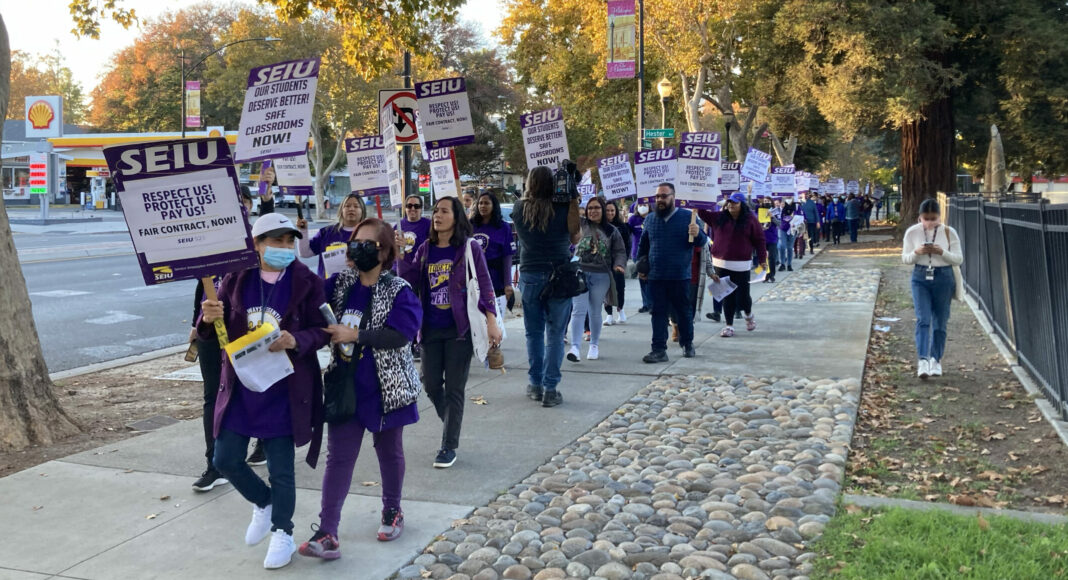As historian Jacques Barzun once wrote, “Teaching is not a lost art, but the regard for it is a lost tradition.” The underpaid and overworked paraeducators in Santa Clara County might concur.
These members of the SEIU 521 union filed an OSHA complaint against the Santa Clara County Office of Education alleging chronic understaffing. And on Nov. 15, about 150 gathered at Hester Elementary School in San Jose to call attention to what they consider poor working conditions.
Wearing purple shirts and holding signs, they protested pay as low as $23 an hour and staffing shortages that have resulted in safety issues affecting both students and teachers.
Paraeducators cited numerous complaints that have fallen on deaf ears among the superintendents and upper management.
According to union spokespersons, special needs students have thrown fecal matter, pushed paraeducators in front of buses, given their teachers black eyes and bitten their teachers’ arms so hard that bones showed.
Sarah Gianocaro, SEIU 521 chapter president and an occupational therapist for the Santa Clara County Office of Education, recounts the types of behaviors that put students at risk: playing with bowel movements in the bathroom, chewing on a rusty nail and swallowing liquid paper. Such behavior must be documented in an Individualized Education Plan that alerts staff to possible safety issues.
An IEP is a plan or program developed to ensure that a child with an identified disability who is attending an elementary or secondary school receives specialized services.
Teachers don’t blame the students; they emphasize that even one student is a handful. They believe the treatment by the Santa Clara County Board of Education to their teaching staff is demeaning and demoralizing—and the lack of appropriate training for new teachers exacerbates the problem.
“They need to hire more staff trained in behavior intervention strategies. The bare-bones team we have can’t get everywhere we have classrooms around the county office. It’s not realistic that only a handful of BCBA [Board Certified Behavior Analysts] can address the needs of our thousands of students.”
Norma Castaneda, a paraeducator since 1999, also shared her troubling experiences. “A para[educator] and a teacher ran out to chase down one of our students with high-risk behaviors. We were at a cross light and the student wanted to cross the street,” Castaneda recalls. “Literally, a VTA bus stopped right in front of them and [the student] almost lost her life. It could have been an ugly scene.”
These are just some of the examples given by educators who assert that the pay provided isn’t worth risking bodily harm and does not ensure the quality of education that students require.
“They need to pay a competitive wage so that delivering packages for Amazon isn’t a more attractive option both financially and in terms of safety,” Gianocaro said.
David Maldonado, a paraeducator for 28 years, speaks to the wage issue: “So you come to South San Jose, and you want to work your butt off here. But it’s hard to afford anything here anymore. So you know, me and my wife … we work four jobs. Okay, that covers our rent, that covers our bills, that covers the food, that covers the gas. But that’s all it covers, you know, and with everything going up, we need a raise.”
Gianocaro said administrative staff can’t fully understand the day-to-day stresses faced by paraeducators because they only walk through the classroom for five minutes when they visit the various campuses.
“There was a severe discrepancy between what we pay our staff and what they could get for entry-level jobs. Or what you could get working for another COE,” Gianocaro says. The administration has been less than understanding in their request for higher pay, she argues. “You know, they’ll do a salary study, and they’ll compare it to like really tiny districts that don’t pay very well and be like, Oh, we’re really great. It’s like, Yeah, but you left out the fact that, you know, those students have way less needs than our students.”
Negotiations between SEIU 521 and the Office of Education are ongoing as of Nov. 22.
SEIU 521 union officials are planning to host a virtual safety town hall meeting on Nov. 30 with invitations going out to “staff from all bargaining units, parents and concerned community members and government officials.”
“We believe that significant change is needed to ensure the safety of our students and staff and hope that bringing everyone together will help us build upon the approximately 14 solutions we’ve already proposed to management,” said Gianocaro.




I am a retired teacher from SCCOE. The students have become more and more severe. Districts don’t want to serve these students. In the past maybe only 1-2 students had severe behaviors but now it has increased making it difficult to manage. Class sizes are just as large as when we had less severe behavioral students. This is clearly a difficult problem to solve. The para-educators our leaving for jobs with better pay and longer hours. I think they have increased their hours to 6 but it still isn’t enough. I’m n the 70’s they had 7 hour positions. Many of the injuries are permanent. I personally broke my foot on the job, hurt my back, and had many bites by students one on my face. Our para-educators are dedicated but some have left to work at Valley Medical.